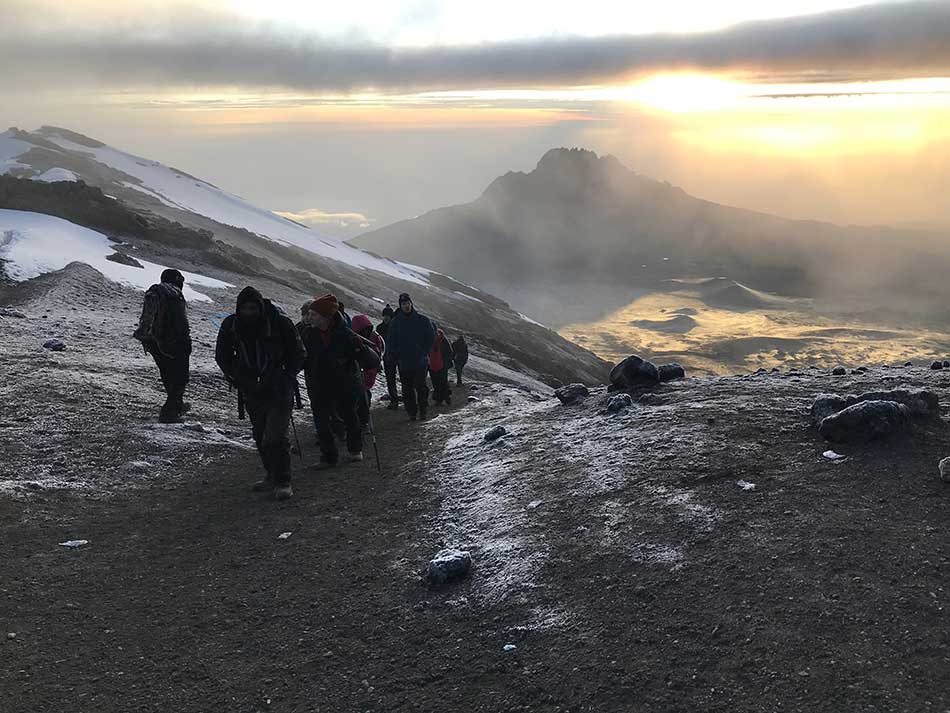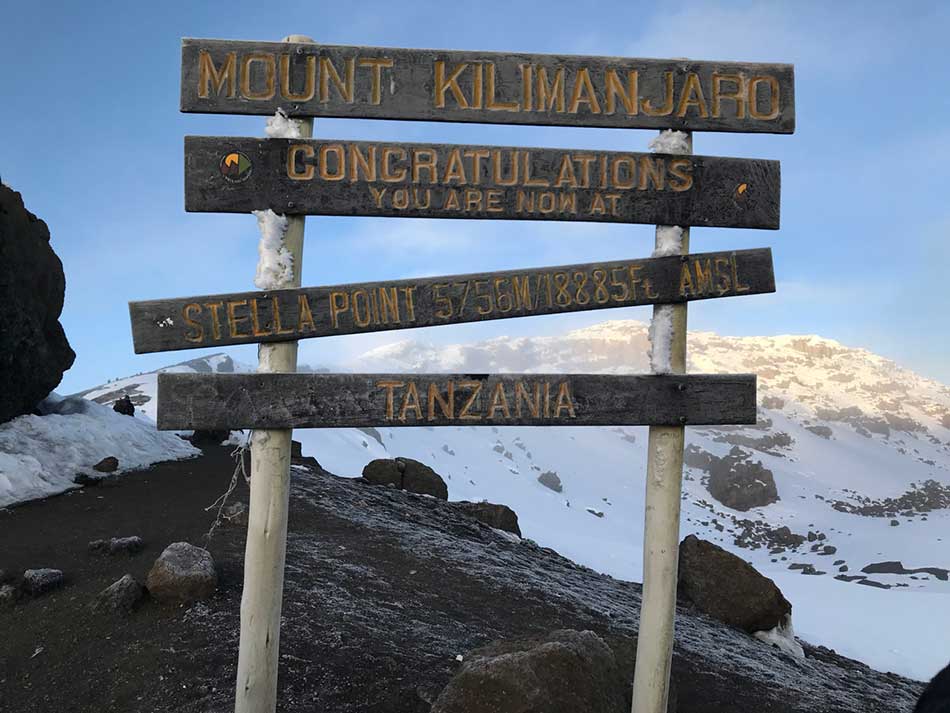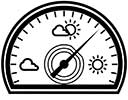Kilimanjaro Trek Day 6 – Summit Fever
Kilimanjaro Trek Vital Stats
Barafu Camp to the Summit and back
- Distance: 7.55 miles
- Starting Elevation: 4573m
- Ending Elevation: 5895
- Total Climbing: 1227m
- Total Descent: 1241m
- Highest Elevation: 5895m
- Total Time: 10:01:30
- Moving Time: 4:03:24
- Calories: 3207
After a few hours resting but not really sleeping I heard David’s familiar voice outside my tent whispering “Alan, it’s time to go”. I think it was 11:30pm as planned. Summit night was here, the excitement was mounting. I responded and then got out of my sleeping bag by torchlight and started manouvering myself into the many layers of clothing I’d been instructed to wear. First a thin pair of socks, followed by a thicker pair of walking socks. I thought that 3 pairs would be overkill and probably uncomfortable so only went with the two – surely they wouldn’t make me take my boots of to check?! On my legs I had a thin pair of alpaca wool tights, some fleecy trousers and a pair of hiking trousers. My waterproofs could go over the top of these to keep out the wind and take it up to 3-4 layers (close to the 4-5 I’d been told to wear). Up top I had a very thin merino wool base layer, a slightly thicker base layer, a fleece and my down jacket. Again, with a waterproof outer jacket that had me just one layer below the minimum 5-6 layers that I had been told to wear. I was already hot though so my hat and gloves went in my pocket for easy access and I put an ever useful buff around my neck.
I had everything organised before going to bed so I was ready in no time and headed to the mess tent for breakfast. Popcorn and biscuits with a couple of cups of Milo and then some egg and a coffee if I remember rightly. I felt a little claustrophobic in the mess tent with quite so many clothes on though so sat outside for a while before being told to sit back in the tent. The neoprene back brace that I was wearing was adding to the insulating properties as well, but after yesterdays painful walk I thought it was a good idea to wear it. I had a knee support in my rucksack as well. I also dosed on on some medications whilst waiting. 250mg of Diamox as instructed, 600mg Ibuprofen for the headache, back and knee pain and a precautionary Imodium to prevent any toilet related emergencies. Maybe this should become a custom for me prior to any big events, especially if I’m off for a long run as they always seem to end in some sort of a toilet emergency. (Sorry, I know, “TMI”.)
I seemed to be sat there for ages waiting for everyone to get ready and as I was I just got more hot and flustered. I think we finally set off just before 1am, a little later than planned but it wasn’t a problem. In fact it meant that we weren’t necessarily in a large procession up the hill as plenty of people had set off before us and were therefore already partway up the mountain. We could see their lights zig-zagging their way along the path far above us.
Headlights on and we fell into line single file behind Nelson. Hussein and Conrad were close at hand, as were Emmanuel and Godfrey. Some people had already given their rucksacks to one or other of the porters which was probably a good idea. The pace was of course very slow as we plodded our way up out of camp. The initial stage was to weave our way up the rocky slope towards the hut and the sign for Barafu Camp. Our campsite had been quite a way below this so we were just retracing the steps we had made the day before to regain the official 4700m elevation of the camp.
I was far too hot so requested a break at the hut so that I could take off some layers. Waterproof trousers, waterproof jacket and my fleece were removed and stored away in my rucksack and then we set off again. This time we were heading into new territory, steeper gradients, higher elevations and new trails towards the summit. In the darkness, the lights of other trekkers appeared to be floating in space miles above us as we plodded slowly onwards.
There were a few little rocky clambers and then it was onto a zig-zag path with a soft gravelly surface underfoot. Despite the steepeness, the slow pace made it easy going if it weren’t for the fact that I was still far too hot. My exposed hands and head felt fine, but my legs and core were still overheating and I could feel myself beginning to sweat. I felt as though I was just being awkward as everyone else was clothed from head to toe in many many layers and some were still cold. I should have trusted my own instincts and known that I wouldn’t need any where near as many layers as they had suggested. At the next stop I took off some more layers. I think the guides thought I was mad and that I would only be clamouring to get them back on again soon, but I knew I’d be fine.
This time I had to take my boots off as well so as to take my fleece trousers off and also took the thicker of my two top base layers off. I would have liked to have taken my alpaca wool tights off as well, but this would have meant getting pretty much naked. The brief moment I had with just the tights on was glorious as a cool breeze refreshed my slightly sweaty nether regions. The alpaca tights aren’t for public viewing though so I put my hiking trousers back on over the top of them. I was now down to two layers on my legs (but would have preferred one) and a base layer plus my down jacket on the top. I did have my down jacket unzipped though. The temperature must have been just below freezing at this elevation and that felt fine. My gloves and hat were still close at hand in my pockets should I need them.
Everything that I had taken off had been stuffed into my rucksack, along with the required 3 litres of water, a whole collection of snacks, spare headtorch, spare batteries, toilet paper and a few other essentials such as spare laces, camera and crampons. With all the extra, unnecessary clothing it was getting quite heavy now. Everyone else had given their rucksacks to the porters by this stage, so I decided to swallow my pride and let Conrad carry my rucksack from here on. Unfortunately for Conrad, I never did put any of the layers back on, nor did I use any of the spares that I had in the bag. I also only drank about 200ml of the 3 litres of water we had been told to carry. All of which meant that Conrad ended up carrying all of this to the summit and then carrying it all back down again – Thanks Conrad!! 🙂
The going was easy thanks to the slow pace, although saying that we were catching and overtaking quite a few of the groups who had set off before us. We also, rather ominously, saw quite a few people being assisted or nearly carried back down. Presumably they hadn’t made it to the top and had to turn back. The slow pace was punctuated with various chants, cries and whistles. “One Team, One Dream, Non Stop, To the Top” These escalated a little as we overtook other groups but things were much more quiet and sombre when we saw people heading back down.
Another common cry was that of “Oi Oi Pucheraa” (spelling unknown) which was apparently Punjabi for ‘Go on my Son’. Simran had taught the guides this and they seemed to love it.
As we climbed ever higher I was feeling fine. My headache had gone, my knee felt fine. My back had the occasional twinge but was generally OK and the going felt really easy. I was however mindful of some of the warnings in accounts I’d read of summit night. Stedman in his Trekkers guide to Kilimanjaro says:
“Picking your way through the trail of knackered trekkers and exhausted assistants, ignore the sounds of people retching and sobbing and remember to keep your pace constant and very slow, even if you feel fine; you’ve come this far and now is not a good time to get altitude sickness”
Kilimanjaro, Henry Stedman
We were still in a regimented single file and our guides were maintaining that slow steady pace. There was no chance of doing anything else even if I felt the urge to do so. It may have been slow and a little too slow for my liking but probably for good reason. The fact that I felt good meant it was all OK anyway. I imagine if I’d felt terrible that the slow pace would have been frustrating, but on we went climbing ever higher.
I was expecting things to get steep and slippery at some point. Again, Stedman’s account of the final push to Stella Point says:
“… it’s a painful, tear-inducing half hour on sheer scree. The gradient up to now has been steep, but this last scree slope takes the biscuit; in fact it takes the entire tin. In just about everybody’s opinion this is the hardest part of the climb, when the cold insinuates itself between the layers of your clothes, penetrating your skin, chilling your bones and numbing the marrow until finally, inevitably, it seems to freeze your very soul… The ground underfoot is just one more obstacle at this stage… causing you to slip back with every step… Whatever way you choose [to negotiate it] you’ll find it hard work.
Kilimanjaro, Henry Stedman
I was feeling good and actually quite looking forward to some of this. Something a little more strenuous would have been quite welcome. I was also feeling lovely and cosy with just a couple of layers on and still hadn’t even resorted to a hat. So much for the cold freezing my soul. The temperature did drop as we climbed up towards the snow-line but it just made me more comfortable as previously I’d been a little too hot. I did put a thin pair of gloves on towards the top as my hands were exposed holding onto my poles, but they were never cold.
As for the increase in gradient and the slippery scree, that never seemed to materialise either. As the darkness faded a faint glow of light could be seen behind us and the jagged silhouette of Mawenzi could be seen. Conrad pointed out a few faint lights to me a little way ahead on a ridge that he said was Stella Point. He also told me that this was now the hardest part of the climb. I didn’t really notice any difference. The so called slippery scree only turned out to be a fairly fine grained gravel. It was easy to gain purchase on it as your boots could dig into it if necessary. Things may have steepened a little but at our slow pace it was never an issue. We stopped to take some photos of the sun rising from behind Mawenzi and continued on towards Stella Point.
From here it was just a short push up to the crater rim and Stella Point itself. What I hadn’t realised until looking back at the photos is that Conrad and I must have arrived here just a little before the others as I seem to have had time to get my camera out and take a photo of them all arriving.

Once we were all there it was time for a little break and some photos. We were now at 5756m, the highest I had ever been by a long way, and higher than Russia’s Mount Elbrus, which at 5642m is the the highest peak in Europe.
We stopped long enough to take in the views, have a little chat and a snack but we still had another 200m or so of elevation to reach the summit and a walk around the crater rim that should take somewhere between 45-60 minutes. The path to the summit was calling and we could see the snow-covered crater rim curving it’s way around towards it.
Off we set in search of the summit. The going here was easy, the gradient was next to nothing and despite the snow underfoot it wasn’t too slippery. There was no wind, the sun was shining and all was good with the world. The views into the crater itself to our right were spectacular, but the stunning glaciers to our left competed with them. The path was quite busy, not only with people heading up to the crater, but also with those coming back down (either under their own steam or assisted by guides and porters).
Eventually, the sign that we had seen in so many photos materialised in front of us, along of course with a fairly large group of trekkers all queuing for the iconic photo. We waited our turn and then had a few photos individually and as a group. We had made it. We were at the summit of Kilimanjaro, 5895m (19,341 feet) in elevation and the roof of Africa. The highest point on the continent, one of the 7 Summits and on top of the tallest free-standing mountain on the planet!
We had a little bit of time to look around but not much. The glaciers that could be seen near to the summit and down in the crater itself warranted exploring. The crater itself was much larger than I had expected. I knew it was big and knew that it was 2.7km across at its widest point and that its central ash pit was 350m deep, but until you see it is is hard to picture. It was huge and once again it would be nice to uncover some of its secrets, but there was no such time for exploration. We soon had to start making our way back down the mountain to safer elevations.
I donned my cramp-ons, took one last photo and then fell into line to catch the others who had already started back down.































Wow ! Amazing photos and glad you made it without having to show your tights to your fellow trekkers ! X
Woo hoo! Congrats.